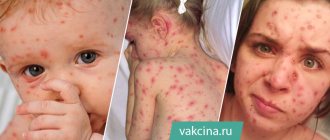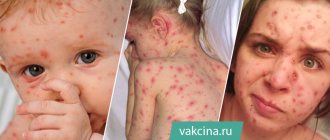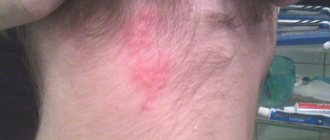General practitioner (family doctor)
Gutorova
Natalia Konstantinovna
22 years of experience
Doctor
Make an appointment
Chicken pox, or, as they say, varicella, is an acute viral disease that occurs mainly at a young age and affects the skin. The pathogen belongs to a type of herpes virus and, after penetration into the body, remains in it for life. So, after the disease passes, it remains in the nerve cells.
General information about the disease
Chickenpox or chickenpox is an acute infectious disease that primarily affects children.
Children aged 5–9 years are most often affected. Only 10% of the total are teenagers over 14 years of age and adults1. For them, children with chickenpox become the source of infection. The causative agent of the disease is human herpes virus type 3 - Varicella Zoster. It is transmitted by airborne droplets (along with droplets of saliva from sneezing, coughing, etc.) or by direct contact with the affected skin of a patient.
According to statistics, from 500 to 800 thousand new cases of chickenpox are recorded annually: this is 570 cases per 100 thousand people. Peak incidence is autumn and winter1.
Important! The chickenpox virus is unstable in the external environment and can remain active for no more than 15 minutes. Despite this, it is capable of spreading over long distances with air currents, including into adjacent rooms through the ventilation system.
Is chickenpox a mild infection?
In the vast majority of cases, the disease has a mild to moderate course in childhood and a severe course in adults. However, complications of chickenpox in adults are rare - no more than 7% of the total number of cases.
Most often, complications develop with concomitant diseases that reduce the body’s immune strength (for example, diabetes mellitus, HIV infection, cancer) and during pregnancy.
Among the most common complications:
- inflammatory lesions of the lungs and brain;
- inflammation of the heart, liver and kidneys;
- bacterial infections of the skin, soft tissue and bones2.
Chickenpox and herpes zoster
With rare exceptions, people only get chickenpox once. However, this type of virus is able to remain in the body. Most often it hides in the nerve ganglia along the spine2.
When the immune system is weakened due to hypothermia or immunodeficiency states, the virus is reactivated, resulting in the development of herpes zoster. It manifests itself with characteristic skin lesions and pain.
Chickenpox during pregnancy
Chickenpox is a serious danger for pregnant women, especially in the first trimester. Intrauterine transmission of the virus can cause developmental abnormalities (limb deformities, microcephaly, hydrocephalus, soft tissue calcification, growth retardation) and intrauterine fetal death3.
A pregnant woman can get chickenpox, which poses a great danger to the baby. Photo: patchananp.gmail.com / Depositphotos
When a pregnant woman falls ill 1–4 weeks before giving birth, in 50% of cases chickenpox is transmitted to the child. Despite a high titer of passive antibodies obtained from the mother, 23% of newborns develop a clinically significant infection. Infection can occur both through the placenta and through the mucous membranes of the birth canal3.
If the pathology occurs within 1 week before or after birth, newborns are at high risk of infection, because maternal antibodies do not have time to be transmitted to the child. The most dangerous is the appearance of a characteristic skin rash in the mother 5 days before birth or within 2 days after. In these cases, a severe neonatal form of chickenpox develops with high mortality in newborns (up to 30%3).
The disease poses a risk to the expectant mother. According to statistics, pneumonia occurs in 10–20% of pregnant women with chickenpox and is more severe in the long term3.
Possible complications
As a rule, the disease goes away without serious consequences, especially if you do not scratch the papules. However, in rare cases, complications after chickenpox can still occur.
Among them:
- bacterial infection caused by streptococcus;
- viral pneumonia, which is more common in children of the first year of life and manifests itself in the form of high body temperature, excessive paleness of the skin, dry cough and severe shortness of breath even at rest;
- temporary disruption of the central nervous system;
- encephalitis;
- chickenpox meningitis.
To avoid such consequences, monitoring of the development of the disease and treatment must be carried out under the supervision of a physician - therapist, pediatrician or infectious disease specialist.
Incubation period and course of the disease
The incubation period is the time interval between the time a person becomes infected and the first symptoms of the disease appear. With chickenpox, it can range from 10 to 21 days.
Important! A person becomes infectious at the end of the incubation period. Most often this happens even before the first signs of the disease develop. The patient ceases to be contagious 4–5 days after the last rash appears.
After the incubation period there are 3 others:
- prodromal: no rash yet, general weakness, lasts 1–2 days;
- period of rash (with extensive clinical symptoms): characteristic rash, lasts 7–10 days;
- recovery (convalescence period): the rash disappears, the general condition returns to normal, takes 1–2 weeks.
During the prodromal period, body temperature may rise, and the person begins to feel sick. However, there are no specific symptoms of chickenpox.
The recovery period for people with weakened immune systems can be up to 4 weeks.
How can you get infected?
Chickenpox is caused by infection with the Varicella Zoster virus (HSV-3, or herpes simplex virus type 3). During the incubation period, which lasts 2 weeks, an adult may not experience chickenpox symptoms.
Doctors have noticed that the older the patient, the more time passes before pronounced signs of pathology appear. For example, the body temperature of an infected person may rise after 3 weeks of contact with a carrier of the virus.
How is the chickenpox virus Varicella Zoster transmitted? Doctors identify three routes of transmission:
- Airborne (through saliva, during sneezing).
- Tactile (close communication, kissing).
- Close contact with a person with herpes zoster.
The pathogen enters a healthy body through the epithelial tissues of the respiratory tract, then moves to regional lymph nodes. The virus enters the bloodstream along with lymph and causes intoxication syndrome. Externally, the disease manifests itself on the skin and mucous membranes in the form of blistering rashes.
Re-infection with chickenpox is possible with HIV, after chemotherapy and organ transplantation. The state of the immune system in such patients is unsatisfactory, which is why relapses of many diseases occur.
Chickenpox symptoms
All clinical manifestations of chickenpox can be divided into two groups: general and specific. General ones include symptoms that are also observed in other pathologies, such as:
- increased body temperature, usually in the range of 37-39°C;
- headache, general weakness and malaise;
- loss of appetite;
- feeling of aching muscles;
- swollen lymph nodes, mainly in the neck and behind the ears;
- less often - diarrhea, abdominal pain, nausea and vomiting.
Specific manifestations of chickenpox (in both adults and children) are skin rashes (exanthema). They are characterized by stages of development.
Due to the fact that the rash appears on different parts of the body at different times (with an interval of 1-2 days), it seems that the rashes are different. In fact, they are the same, just at different stages. This phenomenon is called false polymorphism.
Possible rashes with chickenpox
Chickenpox affects not only the skin, but also the mucous membranes of the mouth and genitals. Such a rash (enanthema) is possible in severe cases of the disease. The rashes are similar to skin rashes, but are more pliable and break open more easily, leaving painful erosions. When the mouth is affected, severe pain occurs when eating, and enanthema of the genital organs is accompanied by pain when urinating4.
Stages of development of skin rash with chickenpox
- Red spots no larger than the diameter of a match head. Most often they occur on the face, neck, behind the ears, scalp and hands.
- Papules and vesicles. After a few hours of appearance, the spot turns into a small formation (papule) raised above the skin level. A cloudy liquid (vesicle) begins to accumulate there. There is a chaotic spread of rashes throughout the body, and severe itching occurs. The vesicles are soft to the touch and rupture easily when pressed.
- Pustules. A feature of chickenpox in adults is suppuration of the vesicles, resulting in pustules. There is a pronounced enlargement of the lymph nodes. The temperature rises to 39-40°C (observed in approximately half of patients4).
- Crusts. 2-3 days after the appearance, the elements of the rash open up on their own, leaving erosions. A yellowish or brown crust quickly forms on the surface. It gradually dries out and disappears in 10–20 days.
Important! The rash usually remains on the skin for 7–10 days. Rashes should never be scratched or squeezed. Mechanical damage to the resulting crusts is one of the reasons for the appearance of age spots and scars on the skin.
Figure 1. Chickenpox skin rash stages: from red spots to vesicles (blisters) that break open and become crusty. Photo: rob3000/Depositphotos
Answers to common questions
Is there a way to prevent chickenpox?
The preventive measure – not to contact people who are sick – is not always effective. The fact is that infection can occur even before the first manifestations of the disease are detected in the patient. That is, he can communicate with friends without knowing that he is contagious.
It is possible to prevent the onset of the disease by vaccination with special live vaccines, which are based on a weakened chickenpox virus.
Which specialist should I contact for treatment?
Chickenpox in children is treated by a pediatrician or pediatric infectious disease specialist. If an adult gets sick, you should call a therapist or an adult infectious disease specialist immediately after detecting the first symptoms of chickenpox.
Is it possible to swim if you have chickenpox?
Due to the fact that the quality of tap water in most cities leaves much to be desired, in case of this disease you should take a shower (not a bath) using boiled or filtered water. Otherwise, there may be a risk of a bacterial infection joining the viral form, which, in turn, can cause serious complications. It is better to wash with warm water. It is strictly forbidden to use a washcloth, rub the skin or steam it.
Diagnostics
In most cases, the diagnosis of chickenpox is made based on a conversation with the patient and specific symptoms. The doctor asks if there has been recent contact with an infected person and examines how the rash looks and develops.
If the clinical picture is unclear, the doctor will additionally prescribe laboratory tests confirming the presence of Varicella Zoster activity in the body. Usually carried out:
- Enzyme-linked immunosorbent assay (ELISA). Allows you to detect high levels of IgM and IgG antibodies to the causative virus and an increase in their titer by more than 4 times within 10 days.
- Polymerase chain reaction (PCR). Makes it possible to determine the presence of DNA of the Varicella Zoster virus in the patient's blood.
Differential diagnosis
Chickenpox should be distinguished from other pathologies with similar skin rashes.
Diseases with similar symptoms:
| Name of the disease | Description | Features of the rash | What is the difference from chickenpox |
| Herpes zoster | Viral disease with skin rash and severe pain | A rash appears in the rib area | Occurs in people who have already had chickenpox in childhood. Causes: hypothermia, chest injury or weakened immune system |
| foot and mouth disease | A viral infection that is transmitted through food or water from cattle | Rash predominantly on the hands and in the interdigital spaces of the hands and feet, as well as in the mouth and genitals | Erosion remaining after the opening of the vesicles tends to cluster |
| Streptoderma | Bacterial skin lesions that occur after contact with a patient with a sore throat or other streptococcal infection | Rashes are visible on the face and limbs | The rash never spreads to the scalp. The general condition of the person is satisfactory, body temperature rarely rises |
| Allergic reaction | Individual intolerance to certain drugs | A skin rash similar to chickenpox appears with severe itching and swelling | The rash may appear just a few hours after taking the medicine and disappear just as quickly and without a trace. |
Mild forms of chickenpox are treated at home; in case of moderate and severe forms or the development of complications, hospitalization in an infectious diseases hospital is indicated.
Hospitalization is indicated for severe chickenpox or if complications occur. Photo: Wavebreakmedia / Depositphotos
In severe cases of the disease, drug therapy is carried out using the following drugs:
- Antiherpetic drugs - acyclovir, famciclovir, valacyclovir. Aimed at suppressing the herpes virus and accelerating recovery. Used in a course of 7 to 14 days.
- Non-steroidal anti-inflammatory drugs (NSAIDs) - paracetamol, ibuprofen. Allows you to reduce body temperature and eliminate headaches.
- Antihistamines - loratadine, desloratadine. Prescribed for severe skin itching.
Additionally, doctors can use antibiotics, immunomodulators, vitamin complexes, etc.
What to apply to the rash?
In mild forms of the disease, the only treatment may be local treatment of the rash elements and personal hygiene.
The most common alcohol dyes used for topical treatment are brilliant green or methylene blue. The doctor can also use antiseptics (chlorhexidine, fucorcin) and cosmetics containing zinc (calamine). The latter not only act as an antiseptic, but also eliminate itching.
Calamine is used for various skin diseases, including chickenpox. Photo: benedamiroslav / Depositphotos
Survey
To make a diagnosis, a clinical examination and indication of the fact of contact with a patient with chickenpox is sufficient. Specific laboratory examination is required if necessary to differentiate the disease from other conditions accompanied by a blistering rash.
Laboratory confirmation of chickenpox:
- detection of viral DNA in the blood using PCR - polymerase chain reaction;
- an increase in specific IgM and IgG antibodies in the blood by 4 times or more in 10 days.
- In a general blood test, a decrease in leukocytes and neutrophils and an increase in lymphocytes are observed. In some patients, the level of monocytes increases to 10%. A general blood test has no diagnostic value.
If complications are suspected, an X-ray of the lungs, an ultrasound of the heart, and an MRI of the brain are performed.
Prevention
Preventive measures are divided into nonspecific and specific.
Nonspecific prevention includes general measures to prevent the spread of infectious diseases, including:
- avoid contact with a sick adult or child;
- Regularly carry out wet cleaning and ventilation of the room in which the sick person is staying.
Specific prevention is represented by a vaccine with a weakened live virus. Depending on the specific drug, the chickenpox vaccine is given to adults in one or two doses.
Should I get vaccinated against chickenpox?
The chickenpox vaccine is not included in the National Preventive Vaccination Calendar, but doctors recommend getting vaccinated.
Especially if there was contact with a sick person (within 72 hours) or there are concomitant pathologies or conditions that increase the risk of complications. These include immunodeficiency, cancer, diabetes mellitus, bronchial asthma and chronic renal failure. Absolute contraindications to chickenpox vaccination include:
- allergy to chicken eggs, since a similar protein is used in the preparation of the vaccine;
- individual intolerance to antibiotics from the aminoglycoside group;
- severe immunodeficiency, in which even a weakened virus can trigger the development of chickenpox;
- pregnancy.
As an emergency prophylaxis, immunoglobulin is administered to those who have contraindications to vaccination.
The chickenpox vaccine contains a weakened live virus. Photo: pixs4u / Depositphotos
For people who have already had chickenpox but have a weakened immune system, and people aged 50 years and older, vaccination against herpes zoster is recommended5.
The US Centers for Disease Control and Prevention recommends using the recombinant Shingrix vaccine produced by the British pharmaceutical company (GlaxoSmithKline). Russia does not yet have its own vaccine against herpes zoster. Its production, according to media reports, will begin in 20276.
Vaccination in preparation for pregnancy and after it
A woman who plans to become pregnant and has not previously had chickenpox can be vaccinated at least 3 months in advance of her intended conception. However, breastfeeding is not a contraindication to vaccination. If necessary, the vaccine can be administered in the first months after birth.
Prevention of chickenpox in adults
Chickenpox in childhood usually results in lifelong immunity. However, for people who do not have immune antibodies to the chickenpox virus, especially those who are at risk for developing severe forms of the disease, there is the possibility of vaccination.
Varilrix and Okavax vaccines are registered in Russia. These drugs can also be used for emergency prevention of chickenpox.
Author: Tatyana Uzonina
Expert: Natalya Dolgopolova, general practitioner.
The material used photographs belonging to shutterstock.com
Frequently asked questions
| Questions | Answers |
| Can an adult get chickenpox? | Yes, it is possible if the person did not suffer from this disease in childhood and was not vaccinated. |
| How long do adults get sick? | The duration of the disease depends on the individual characteristics of the body and the presence of concomitant pathologies and can vary from 1 to 5 weeks. On average, the acute phase takes 10–15 days. |
| What to do if your child gets sick and you have no immunity? | In such cases, it is necessary to limit contact with the child and undergo emergency prevention with a vaccine or immunoglobulins. At the same time, it is important to regularly ventilate the room in which the patient is located, carry out wet cleaning in it and use personal protective equipment (mask, gloves). |
| When does a sick person stop being contagious? | It is believed that a person with chickenpox ceases to be infectious to others 4–5 days after the last skin rash appears |
| How long is the incubation period for chickenpox? | The period from the moment of contact with a sick person to the appearance of the first symptoms of the disease can range from 10 to 21 days. |
| Is it possible to wash yourself if you have chickenpox? | If you have chickenpox, you must follow the rules of personal hygiene, including taking a shower. It is important to avoid rubbing the skin with a washcloth. After water procedures, you just need to blot your body with a towel without wiping yourself dry. |
| Is it possible to get infected a second time? | Re-infection with chickenpox, although extremely rare, does occur. This may be due to a sharp decrease in the body's defenses as a result of immunodeficiency states. Only 2% of people get chickenpox again.7 |
| How long does the chickenpox vaccine last? | When the immune system is functioning normally, the chickenpox vaccine is effective for life. |
| Is the chickenpox vaccine dangerous? | In the vast majority of cases, the chickenpox vaccine is well tolerated and does not cause serious complications. Possible adverse reactions include redness, soreness and mild swelling at the injection site, and rarely, minor rashes.5 |
Treatment
Treatment of chickenpox in its standard course occurs at home after consulting a doctor. It is aimed at improving the general well-being of the patient: drugs whose active ingredient is paracetamol are used to reduce elevated body temperature.
In the vast majority of cases, patients suffer from unbearable itching of the skin. To alleviate the condition, special ointments and solutions are prescribed based on zinc and potassium permanganate, with the addition of tea tree oil. Antihistamines may be recommended. Often, a specialist will prescribe ointments whose action is aimed at destroying the viral pathogen.
In more serious cases (especially if there is concomitant shingles), the doctor will prescribe analgesics. In case of extremely reduced immunity, the patient is given immunoglobulins, and in case of intense intoxication of the body, detoxification solutions are administered.
Sources
- Chicken pox: adults at risk. Excerpts from the state report “On the state of sanitary and epidemiological well-being of the population of the Russian Federation.” Publishing house “Russian Doctor”, November, 2022.
- Chickenpox. Mayo Clinic.
- Chebalina, E. A., et al. “Chicken pox in pregnant women: risk, prevention, diagnosis, management tactics (clinical lecture).” Medical and social problems of the world 19, no. 4 (2014): 74-82.
- Yushchuk N.D. et al. “Chickenpox in adults” Attending physician #01/00 (2000).
- Scott Frothingham. Chickenpox in Adults. Healthline. 2018
- TASS News Agency, “Production of a domestic vaccine against herpes zoster will begin in 2027.”
- Rusakov, V. A., A. V. Chebykina, and V. A. Maidan. “Methods of medical control of chickenpox incidence.” Bulletin of the Russian Military Medical Academy S1 (2018): 170-172.









